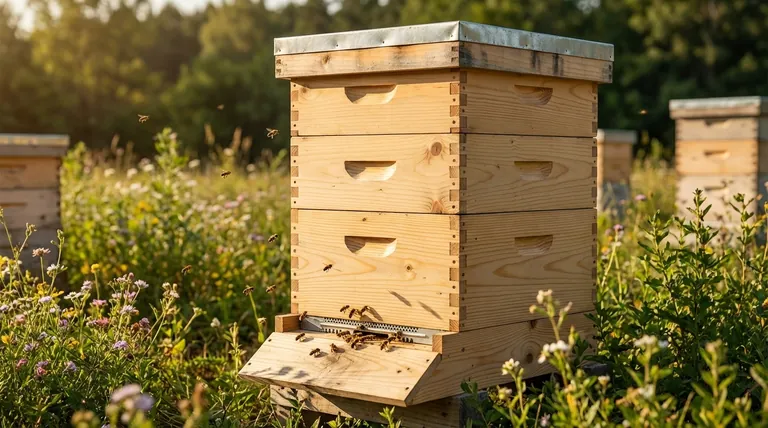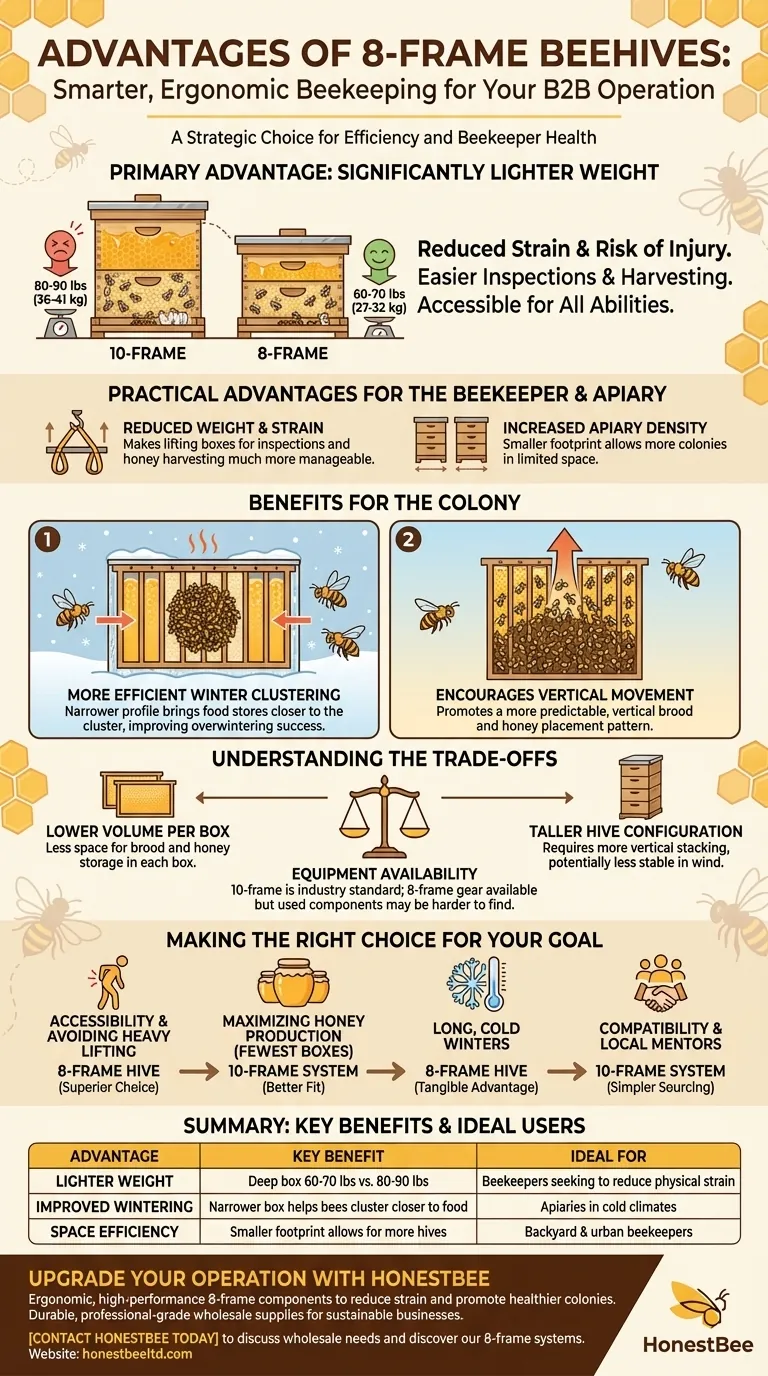The primary advantages of 8-frame beehives are that their components are significantly lighter and easier to handle than their 10-frame counterparts. This reduction in weight makes hive inspections less strenuous, reduces the risk of back injury, and makes beekeeping more accessible to people of all physical abilities.
Choosing an 8-frame beehive is fundamentally a choice for a more manageable, ergonomic system. It trades the higher volume of a 10-frame box for lighter weight and a hive geometry that can be more beneficial for bees, especially during winter.

The Practical Advantages of a Lighter System
The most immediate and noticeable benefit of an 8-frame hive is its impact on the beekeeper. Beekeeping is a surprisingly physical activity, and equipment weight is a major factor.
Reduced Weight and Strain
A standard 10-frame deep box filled with honey, brood, and bees can weigh 80-90 pounds (36-41 kg). An 8-frame deep box is considerably lighter, typically weighing around 60-70 pounds (27-32 kg).
This weight difference is even more significant with honey supers. The reduced load makes lifting boxes for inspections and honey harvesting a much more manageable task, directly reducing the risk of strain and injury.
Increased Apiary Density
The 8-frame hive has a smaller footprint than a 10-frame hive. This allows you to fit more individual colonies into a smaller physical area, which can be a significant advantage for backyard beekeepers with limited space.
How 8-Frame Dimensions Benefit the Colony
Beyond the advantages for the beekeeper, the narrower profile of an 8-frame hive can create a more favorable environment for the bees themselves.
More Efficient Winter Clustering
In winter, bees form a tight cluster to generate heat. The narrower dimension of an 8-frame box means the honey stores on the outer frames are closer to this central cluster.
This makes it easier for the colony to access their food reserves without having to break cluster and risk freezing, improving their chances of overwintering successfully.
Encourages Vertical Movement
Bees in an 8-frame hive tend to fill the frames more completely before moving upwards into the next box. This encourages a more vertical or "chimney" style of expansion.
This can lead to a more predictable pattern of brood and honey placement, which some beekeepers find easier to manage.
Understanding the Trade-offs
While the advantages are compelling, it is crucial to understand the compromises inherent in choosing an 8-frame system.
Lower Volume Per Box
The most obvious trade-off is that each box holds two fewer frames. This means less space for the queen to lay eggs in a brood box and less room for honey storage in a super.
Taller Hive Configuration
To achieve the same total colony volume as a 10-frame setup, an 8-frame hive will require more boxes stacked vertically. This can result in a taller, less stable hive that may be more susceptible to being knocked over by wind or animals.
Equipment Availability
The 10-frame Langstroth hive is the de facto industry standard in many regions. While 8-frame equipment is widely available for purchase new, finding used equipment or borrowing components from other beekeepers is often easier with the more common 10-frame size.
Making the Right Choice for Your Goal
Your decision should be based on your physical abilities, beekeeping philosophy, and local climate.
- If your primary focus is accessibility and avoiding heavy lifting: The 8-frame hive is the clear and superior choice for you.
- If your primary focus is maximizing honey production with the fewest boxes: The 10-frame system's higher capacity per box may be a better fit.
- If you are beekeeping in a region with long, cold winters: The 8-frame hive's compact geometry offers a tangible advantage for colony survival.
- If your primary focus is compatibility and finding local mentors: The 10-frame system is the more common standard, which can make sourcing gear and advice simpler.
Ultimately, selecting an 8-frame hive is a strategic decision that prioritizes the beekeeper's long-term health and the colony's wintering efficiency.
Summary Table:
| Advantage | Key Benefit | Ideal For |
|---|---|---|
| Lighter Weight | Deep box weighs 60-70 lbs vs. 80-90 lbs for 10-frame | Beekeepers seeking to reduce physical strain |
| Improved Wintering | Narrower box helps bees cluster closer to food stores | Apiaries in cold climates |
| Space Efficiency | Smaller footprint allows for more hives in a given area | Backyard and urban beekeepers |
Upgrade your operation with ergonomic, high-performance beekeeping equipment from HONESTBEE.
As a commercial apiary or distributor, managing heavy equipment can impact efficiency and safety. Our 8-frame beehive components are designed to reduce physical strain on your team while promoting healthier colonies. We supply durable, professional-grade beekeeping supplies and equipment through our wholesale-focused operations, helping you build a more sustainable and productive business.
Contact HONESTBEE today to discuss your wholesale needs and discover how our 8-frame systems can benefit your operation.
Visual Guide

Related Products
- Langstroth Bee Hives Bee Keeping Box for Beginners Beekeeping
- Assembled Wooden Bee Frames with Beeswax Foundation Ready to Use by HONESTBEE
- Long Langstroth Style Horizontal Top Bar Hive for Wholesale
- HONESTBEE Professional Long Handled Hive Tool with Precision Cutting Blade
- HONESTBEE Professional Multi-Functional Hive Tool with Ergonomic Wood Handle
People Also Ask
- Why might a beginner be advised to start with a Langstroth hive? Unlock a Supportive Beekeeping Ecosystem
- How does the orientation of the hive sides benefit comb construction? Ensure Straight, Movable Combs for Easier Hive Management
- What basic equipment is needed to start beekeeping? Your Essential Guide to a Confident Start
- Why are Langstroth hives recommended for beginners? Unmatched Support & Standardization
- How does the ease of access differ between 8-frame and 10-frame hives? Choose the Right Hive for Your Body



















